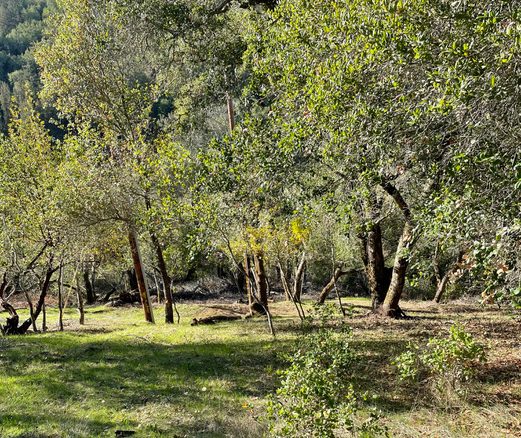When I spoke with Charlie Toledo last week about the forest on our ranch, she said she was always concerned about the overgrowth. First People would have kept the forest thinned with cultural burning so the stream would be accessible to deer and coyotes, so there would be reeds for baskets and the acorns, healthy.
The forest plan for our ranch done by NRCS (Natural Resource Conservation Service) is coming into focus. It will be spread out over three years, beginning, weather permitting, in January. It includes weaving willow along the eroding gully below the goat barn and removing and disposing of 16,000 small bay trees. In anticipation, I have studied ways of the healthy forest as I talk with various experts who know something about these matters.
I never thought forest management to be something that Donald and I would have to consider. I suspect that most of us guardians of forest and oak woodlands just assumed trees take care of themselves. We had no idea how much First People did over millennia to ensure these forests were healthy and resilient. At least, I didn’t.
There are decisions to be made: How to thin out 16,000 bay, and who will do it? What to do with the bodies of the bay? What about carbon sequestration? What to do when the bay trees re-sprout? Use the recommended herbicides or bring in goats? Because we have ignored forest management for almost 200 years, we now have a situation that will have negative consequences no matter what we do. But before I leave this ranch one way or the other, I want to make it less likely that wildfire will be destructive when it comes.
I’ll be honest; I love the undergrowth. It affords privacy. But then, when I see some of the areas on the boundary of our ranch near the PG&E pole where workers limbed up oaks and weed-whacked around them, I reconsider. The effect after the rains brought fresh grass is vibrant. And when we work the deer paths into trails, clearing brush either side to make fire breaks, we afford an intimacy with less accessible reaches of the ranch.
The NRCS forest plan states it has a ten-year life. If we don’t keep tending the forest, it will all regrow in 10 years. This is a lifestyle change. In place of using herbicides, it’s clear that goats and/or prescribed burning will be necessary on an ongoing basis. Isn’t that going back to what First People’s did? There is a lot to learn from those people left who remember traditional forest management practices.
I imagine a crew who offer prayer as they begin, people who respect the forest beings and work with them. We need indigenous reverence as much as traditional knowledge as we address what western European hubris has wrought.
In her talks at our Harms Vineyards and Lavender Fields Open House many years ago, Charlie said that First People’s agriculture was so different that white men couldn’t recognize it. We are living with the sad results. Our first lesson as we suffer the ravages of wildfire is humility.
May the plan address the needs of a healthy forest: fewer bay trees, strengthened oak and madrone, vectors for sudden oak death removed, and fire welcomed in again in less destructive ways. May the forest’s care bring my ear a little closer to Earth.
